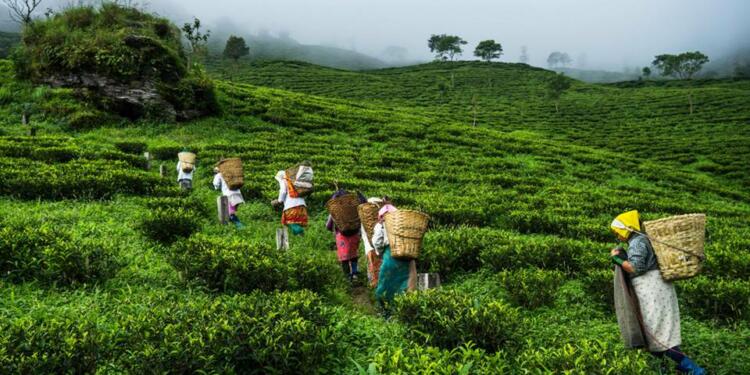“Aji Hum toh Desi hain, hum Chai peete hain” (We are Indians and we drink Tea). This phrase must have crossed your ears an umpteenth number of times. However, nothing could be patently absurd and false from it. Tea is not Indian and in fact, Indians had rejected it as an acceptable beverage. But, all thanks to ruthless capitalism, here we are celebrating our own subjugation.
Brits just loved tea
Tea was originally a medicinal luxury. During the second half of the millennium, the consumption of this beverage became popular among Dutch and Portuguese aristocrats. Soon, it percolated down to the British as well. By the 17th century, the British elites started to consume tea too. From party habits, it quickly changed into a regular beverage. From there on the middle and lower classes of the British society also accepted it. Soon, it became a national beverage in a century.
But, the problem was that the British did not have domestic tea units. They used to heavily rely on Chinese imports for their refreshing beverage. By that time, the East India Company had monopolised Asian Section of British trade policies. They used to import it for the Brits. The payment? Well, they paid for it by the revenue earned from opium trade originating from India. They even fought 2 Opium wars to keep it going.
India’s emergence as tea grower
However, everything exhausts over a period of time and the British officials knew that imports from China would do as well. So, they began looking for alternate arrangements and Indian Territory turned out to be a gold mine for them. Philip Lutgendorf, an Indologist research scholar and cultural historian, has pointed out that by the end of 18th century the British had started to experiment on Indian lands for growing tea leaves.
By the beginning of the 1840s, made-in-India, especially Assamese tea, started to gain fame. While the centre of the tea trade was still in China, traders rushed in considering India as an emerging market. By 1888, Indian tea exports to Britain had surpassed that of the Chinese. But, at what cost?
Need for introducing tea to Indian consumers
Well, Assamese were not interested in tea plantations. So, the British relied on internal migration and brought indentured labourers from Gangetic plains and down South. They were made to toil day and night in these plantations. Many of them died due to overwork and malnutrition. Because of the water intensive nature of tea-plantations, diseases such as Malaria also killed hundreds of Indians.
After a certain point, the export market plateaued. The British had to find a new way and they did not have to look far. The Indian consumer market was right there. But, the problem was that apart from Zamindars and other royal Indians loyal to British Interests, Indians did not like tea much. To increase the consumption of tea in India, the British improvised with the tax policy.
British Government and private sector were hand in gloves
Believe it or not, in 1900, transporting made-in-India tea to Glasgow was cheaper than transporting it to the Gangetic plains. Curzon then taxed the tea trade in 1903. Companies like Brooke Bond and Lipton then felt incentivised to promote tea in India. They embarked on massive marketing campaigns.
To differentiate the evilness associated with Chai, these companies introduced a new version of Chai. The British just used to soak tea leaves in water and drink it. These companies told Indians to use sugar and milk as well, albeit not at once. They started to hold demonstrations at various public places on the proper way of making Chai. Millions of free cups were distributed for more than 3 decades, but to not much gain.
It took 60 years
After the great depression, these companies started to use social coercion for the purpose. For instance, they called white guys as civilised and asked Indians to copy their tea drinking habits in order to become civilised. To coerce Muslims towards this addiction, they sent all women marketing squads in order to convey to their male members that the British and they are equivalent when it comes to their attitude towards women. On a side note, in fact they were.
But, Indians did not adapt to it and then something truly charismatic happened in the 1960s. Somebody in India saved time by mixing tea leaves, milk and sugar and boiled it. It was cost as well as time effective. Until now, two separate stoves and two separate ketlis were used for boiling water and milk. But now it had become efficient. Soon, ginger and other ingredients started to be poured into the container. This gave birth to the products such as masala chai and cutting chai among others.
Also Read: Did Mughals create Banarasi Sarees? Short answer: No, Long answer: Read
Need to acknowledge the history
Indians who had rejected tea are now happily drinking it. Hindustan Unilever, which owns Brooke Bond and Lipton, is in fact the second biggest shareholder of tea industry in India. We in India are one of the largest producers of tea, but export only 30 per cent of our produce. On an average we consume nearly 730 gm of tea leaves per person per year. We are in fact one of the top 30 countries in terms of per capita consumption.
All of this happened just because the British wanted us to drink tea. It does not mean that we should stop drinking it. But there is a need to acknowledge the history behind it. At least we can start terming coffee as Desi products.
Support TFI:
Support us to strengthen the ‘Right’ ideology of cultural nationalism by purchasing the best quality garments from TFI-STORE.COM





























